Guatemala is known for its rich indigenous culture, scenic mountainous countryside, and its many volcanoes (37 exactly, the most of any Central American country) and you can experience all that makes the nation famous in one place: Lake Atitlán. The volcanic lake is situated in the Guatemalan Highlands among the Sierra Madre Mountain Range and surrounded by three volcanoes: San Pedro, Atitlán, and Tomlimán. Bright blue waters lap onto the shores of traditional Mayan villages that line the lake. Although remote and rural, Lake Atitlán packs a punch for travelers eager to tackle sunrise hikes, scoop up Mayan textiles, immerse in Guatemalan culture, and spend time in nature.
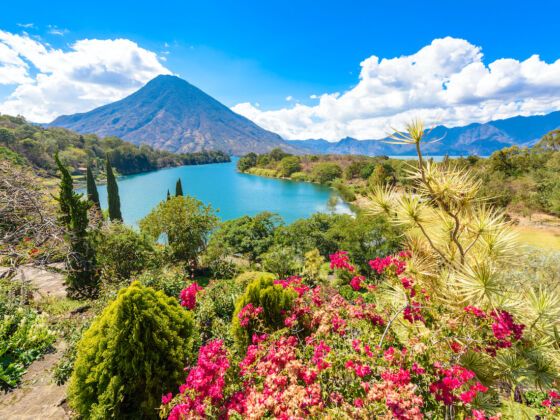

The Ultimate Week in Guatemala's Lake Atitlán, From Sunrise Hikes and Cliff Jumping to Cacao Tasting
Before you go, it’s good to get your bearings with the lakeside villages so you can choose the area that’s best for you to stay. San Pedro La Laguna is the liveliest village with the largest number of backpackers, bars, and hostels; San Marcos La Laguna is the hippie haven stacked with yoga studios, holistic centers, and wellness workshops; San Juan La Laguna is a cultural hub that blends traditional Mayan life with enough restaurants, shops, and tour agencies to keep travelers in the loop; and Panajachel is the bustling market hub that welcomes the daily influx of travelers and local tourists.
Don’t worry too much if you’re unsure of where to stay — boats run constantly between all the villages, making travel between all the lakeside communities very easy. Choose your home base and gear up for a week of adventure, culture, and never-ending scenery in Guatemala’s Lake Atitlán.
Day one – Cliff jumping
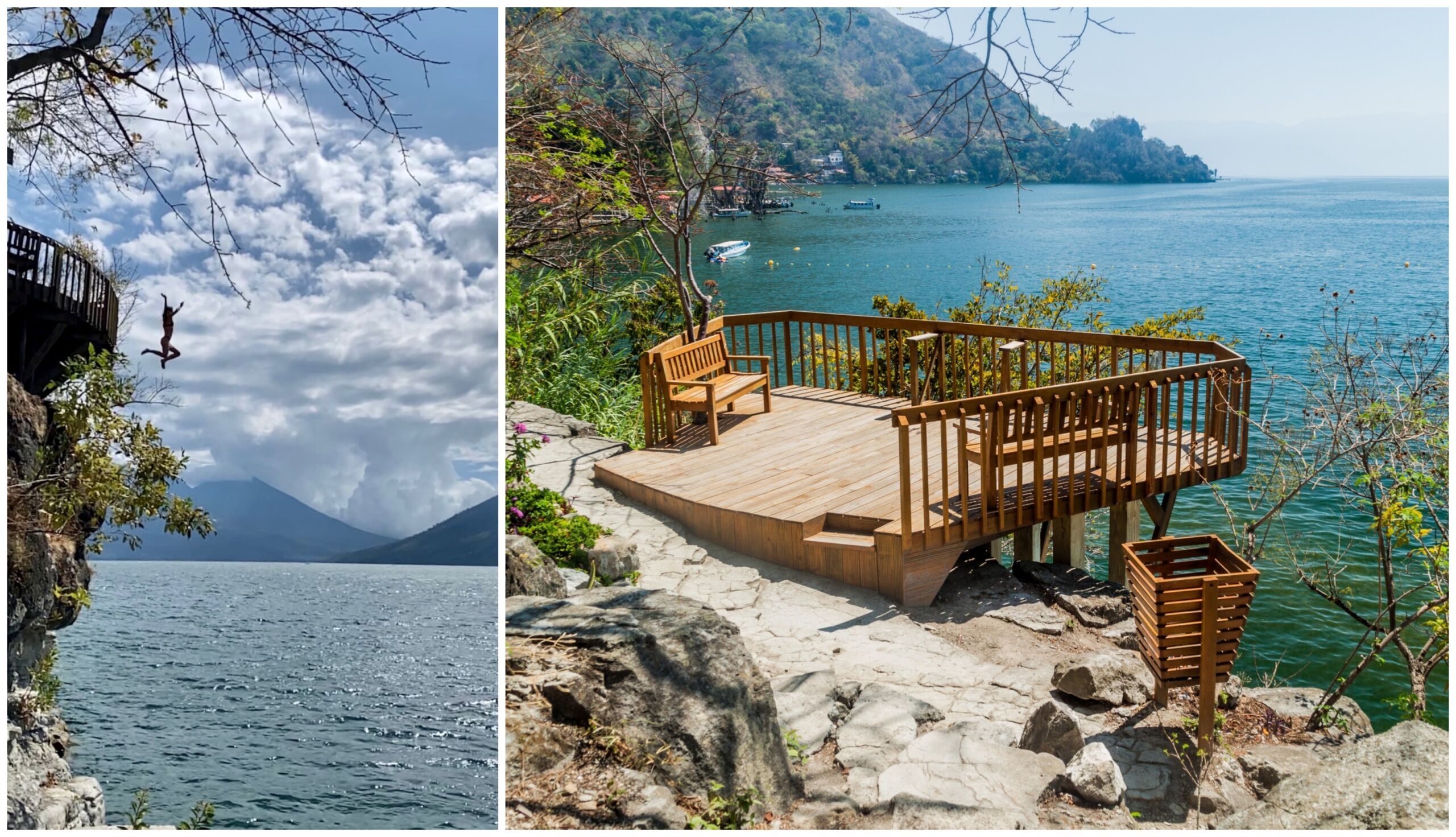
Photo: Fiona Mokry and Matyas Rehak/Shutterstock
From wherever you chose to stay, hop a boat over to San Marcos to kick off your day in Cerro Tzankujil Nature Reserve. The protected hilly expanse is only a 10-minute walk from the San Marcos’ pier and commands a small entrance fee of 15 Quetzales (about 2 USD). Once inside, walk the pebbly paths along the water to find uninterrupted views of the surrounding volcanoes. Trek upward to the Mayan altar, a circular mound of stones upon which candles are burned, situated at the highest point in the preserve. Carry on deeper into the reserve to a high wooden platform suspended roughly 50 feet above the lake. If you dare, take a running start and launch off the platform into the crystal-clear water below. You’ll probably have some fellow travelers sitting on the nearby rocks, cheering you on and watching the show. After you overcome your first-jump jitters, you’ll be lining up to do it again.
Part of Cerro Tzankujil’s appeal is its lack of development and infrastructure. After you get your adrenaline fix, find a peaceful spot to take in the endless mountain views while you sprawl out on a sunbaked rock.
Day two – Sunrise hike up Indian Nose
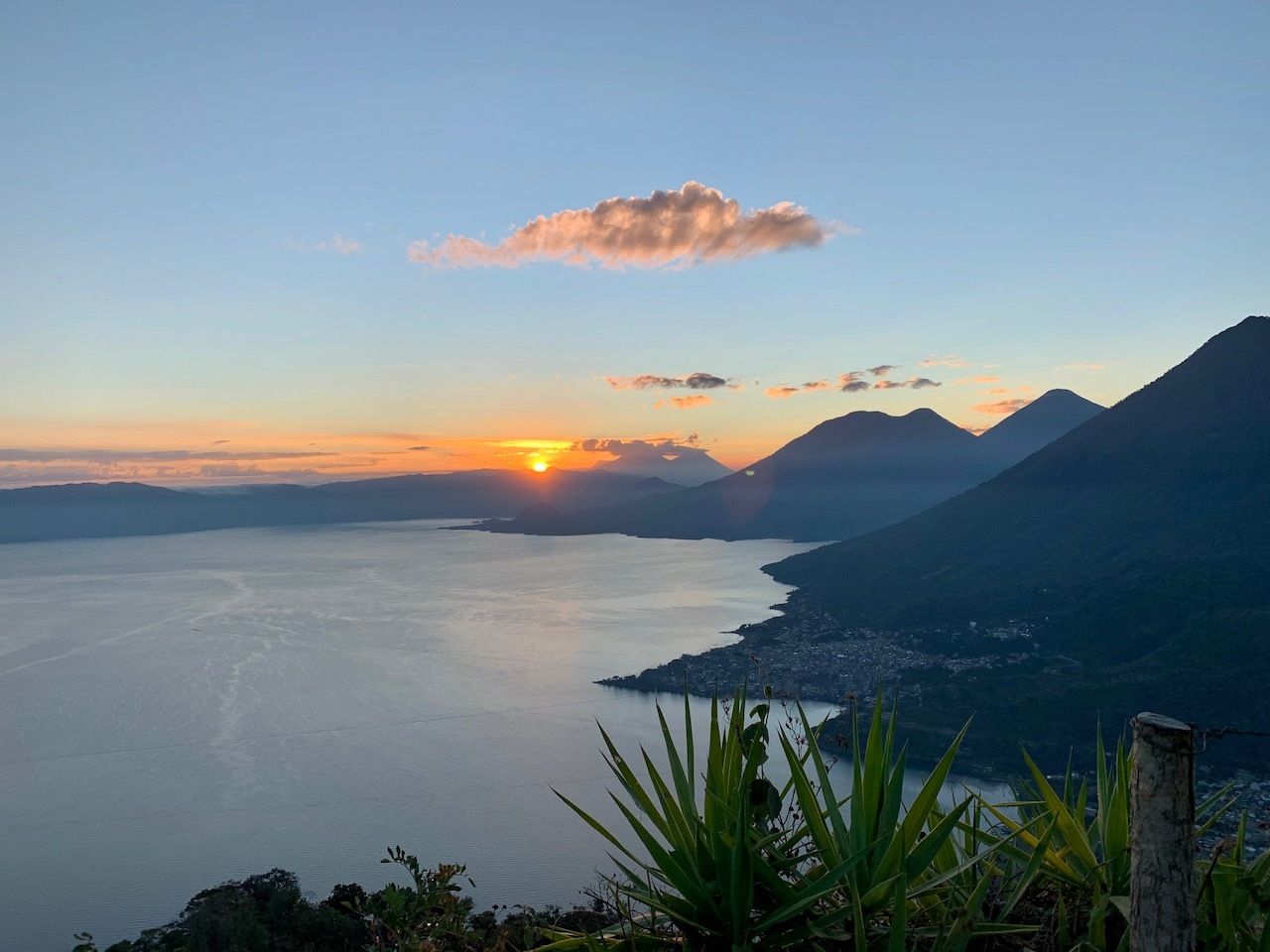
Photo: Fiona Mokry
Catch the sunrise from Indian Nose (La Nariz del Indio), sometimes referred to as Mayan Face (El Rostro Maya), a rocky perch with face-like characteristics and the highest point in Lake Atitlán. While the 3:00 AM wake-up call is rough, you won’t regret it once you reach the lookout point. Since the majority of this excursion takes place in the dark, it’s advised that you book this trip through one of the travel agencies in any of the villages. They provide transportation to the trailhead in Santa Clara and a local guide to lead the way up the cliffs. While Guatemala is a relatively safe country to visit, petty theft does occur sometimes and tourists are warned against walking alone between the villages — especially at night.
The hike to Indian Nose takes between 30 and 45 minutes. You’ll likely hear and see other groups of people as you get closer to the top. After you summit, find the perfect vantage point along the cliff edge or settle into a spot on the simple, two-story wooden platform. Coffee and pastries are passed around by the local guides while everyone waits patiently for the sun to peak over the horizon. Lake Atitlán becomes more and more visible as the sun spills over the lake, and the three iconic volcanoes stand in stark contrast against the pale sky. Daylight finally breaks and reveals perfect panoramas of the striking landscape and many of the lakeside villages. There’s no better way to start the day.
Day three – Co-op hop
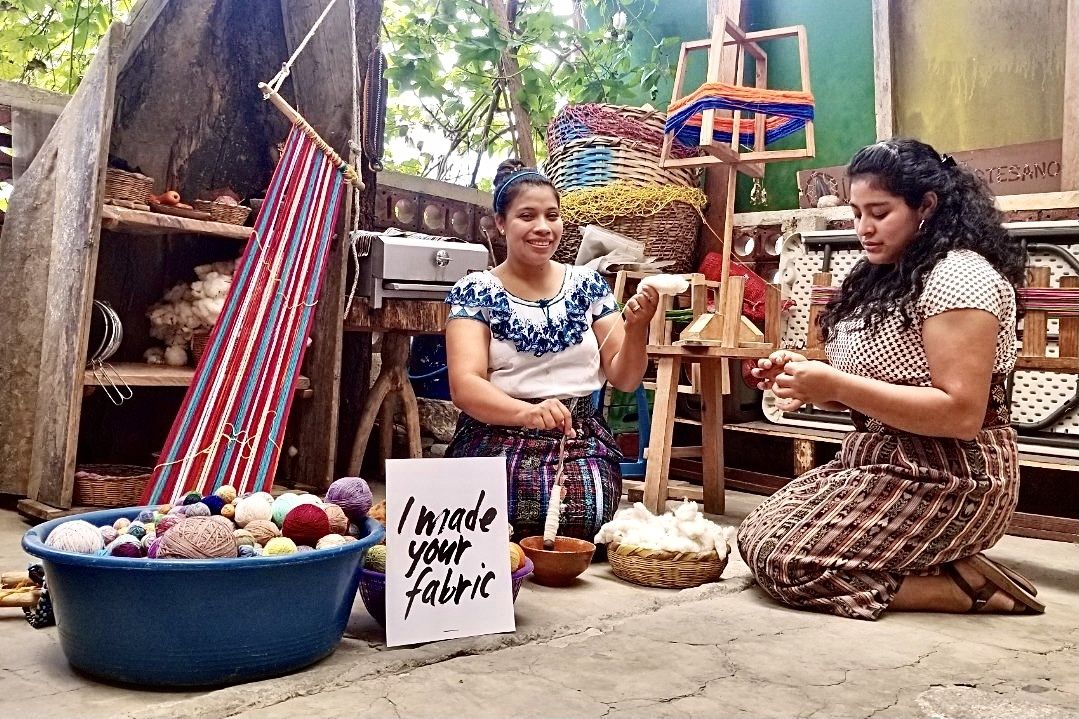
Photo: Fiona Mokry
Lake Atitlán is the center for women weaving co-ops and coffee co-ops. Don’t pass up the chance to visit, take a free tour, and watch demonstrations of how the products are cultivated.
Traditional textiles are sold all over Guatemala, and Lake Atitlán is the source that supplies many of the markets and shops throughout the country. Swing by Atitlán Women Weavers in San Pedro and admire all the handmade scarves, blankets, bags, and clothing. Watch as the weavers perform a free, 20-minute demonstration of how they harvest the cotton, prepare the thread, naturally dye it with color derived from plants and tree bark, and use a backstrap loom to weave beautiful, sustainable textiles. After a morning in San Pedro, take a 10-minute boat ride to San Juan (costing roughly $2) to visit another weaving co-op, Casa Flor Ixcaco. Here you’ll find a different selection of handwoven goods and meet some of the talented weavers.
Continue the co-op hop and check out La Voz Coffee Co-op (Cooperativa la Voz que Clama en el Desierto), also in San Juan. Established by 20 farmers in 1977, the coffee farm and production center sits on the outskirts of the village. Tour the co-op, see how the coffee plants are organically-grown and harvested, and learn about the farmers’ mission to uphold sustainable production. End the tour with a visit to the on-site café for a cup of La Voz’s finest brew.
Day four – Day trip to Chichicastenango Market

Photo: Laura G.Robe/Shutterstock
Despite its location in a small, rural town, the Chichicastenango Market (also known as “Chichi Market”) is one of the biggest in Central America. It’s a two-hour drive from Lake Atitlán, but it’s worth the trip to get your hands on the country’s biggest selection of high-quality handicrafts, textiles, wood carvings, pottery, and jewelry. Chichicastenango has been a trade center for hundreds of years, eventually morphing into a melting pot of vendors from different ethnic groups.
Every Thursday and Sunday hundreds of vendors set up shop around the town’s central plaza and put on a truly impressive display. It’s the perfect place to shop for some souvenirs. Locals also frequent the market to pick up fresh produce, animal products, household necessities, and toys, so take the time to wander around and observe the daily life and local customs in rural Guatemala. Cap the day with a visit to Santo Tomás, the 16th century church in the center of the plaza and a revered Mayan heritage site still used today.
Day five – Kayak Lake Atitlán
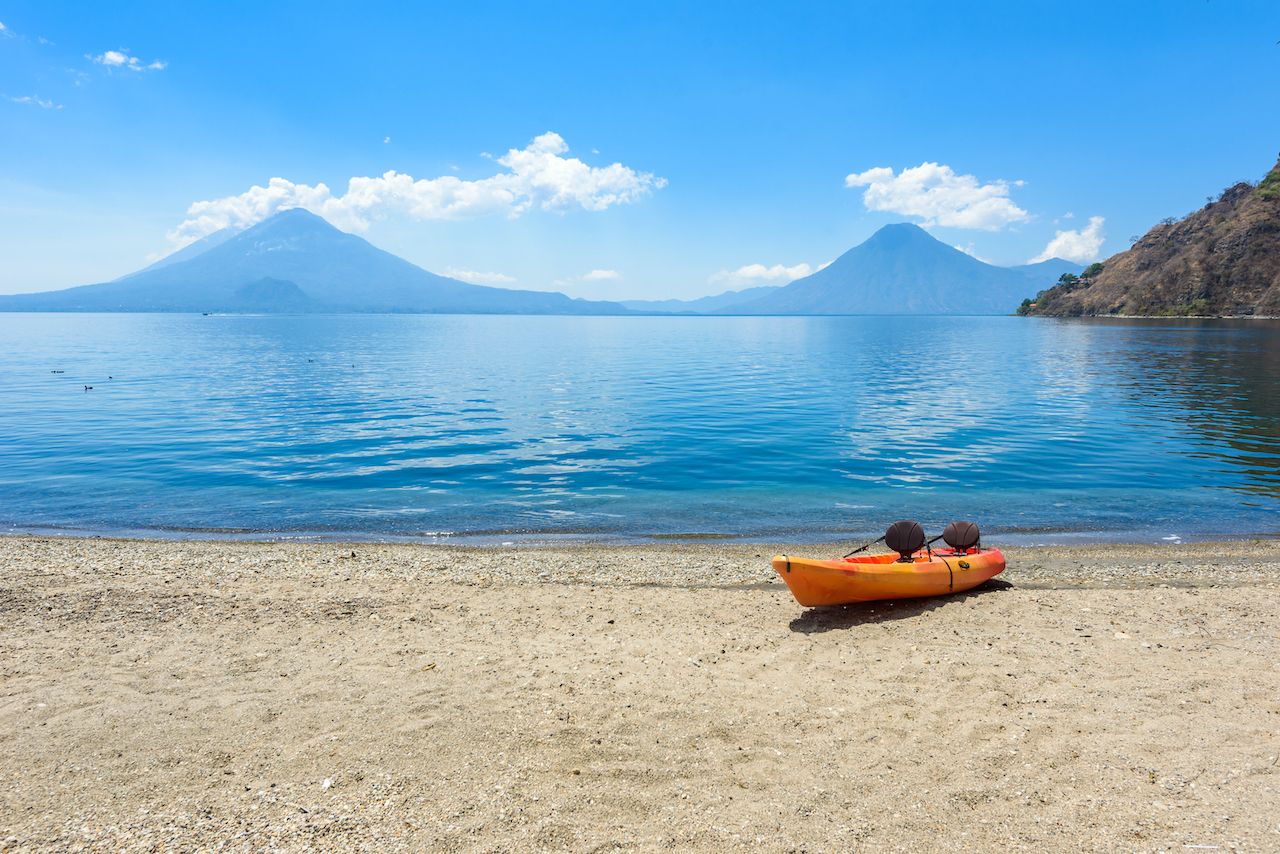
Photo: Simon Dannhauer/Shutterstock
You can admire the beauty of Lake Atitlán from a variety of places (restaurant decks, waterfront bars, boat dock), but nothing beats paddling out on the water and admiring a 360-degrees view of the volcanoes, rolling green hills, and sparkling blue water. Kayak rentals are available in most of the villages, and Mayan Dynasty Tours in San Juan and Maya Travel in San Pedro both offer guided tours. If you find yourself in San Marcos, you can take advantage of the kayak rentals at the entrance of Cerro Tzankujil Nature Reserve. Keep your eyes peeled for local fishermen casting their nets and hauling in the day’s catch.
Day six – Spa Day
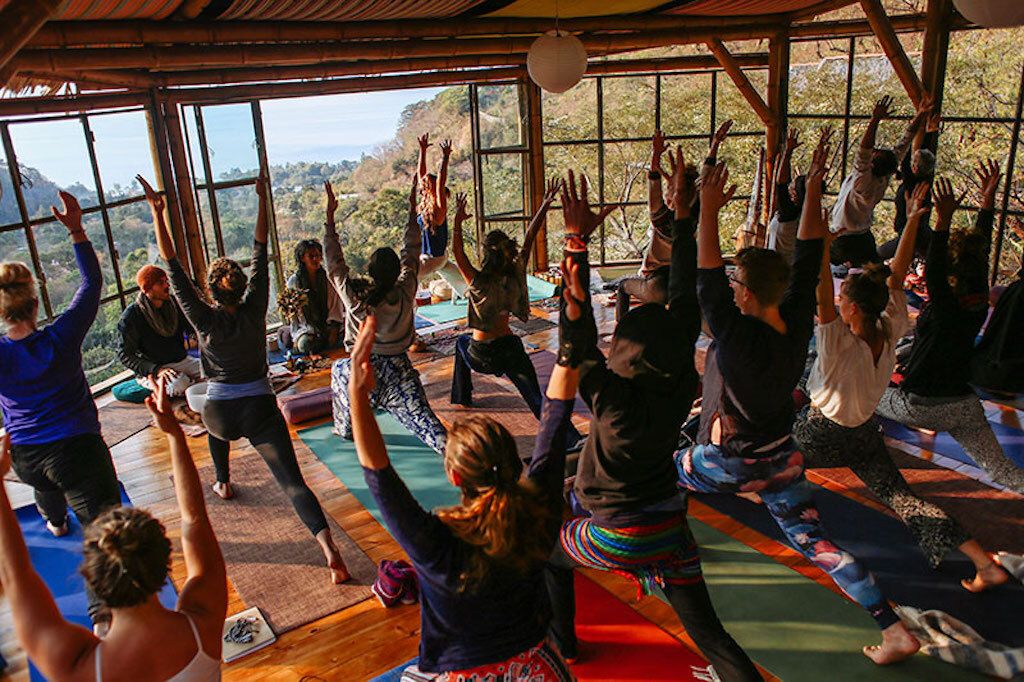
Photo: The Yoga Forest
A number of yogi expats and holistic practitioners have transformed San Marcos la Laguna into some sort of spiritual center, and there’s no better place to relax. Start the day with a waterfront massage at East West Center, an unassuming holistic spa in a peaceful nook off San Marcos’ main drag. Check out their health store on your way out, stocked with all kinds of all-natural, oil-infused creams.
In the afternoon, wander up to The Yoga Forest, a premier retreat center perched high above San Marcos with prime views of Lake Atitlán. The 25-minute trek is worth it for the views alone, but a guided meditation session followed by a Vinyasa or Restorative Yin Flow class is the cherry on top. Further the experience with a traditional ceremony; discover the power of Ceremonial Cacao (AKA “The Food of the Gods”), or cleanse your body and soul with a Temazcal Ceremony, an ancient Mayan steam bath. The Yoga Forest also offers climbing courses and SUP expeditions around the lake if yoga and meditation aren’t your thing.
Day seven – Treat your tastebuds and indulge in culture
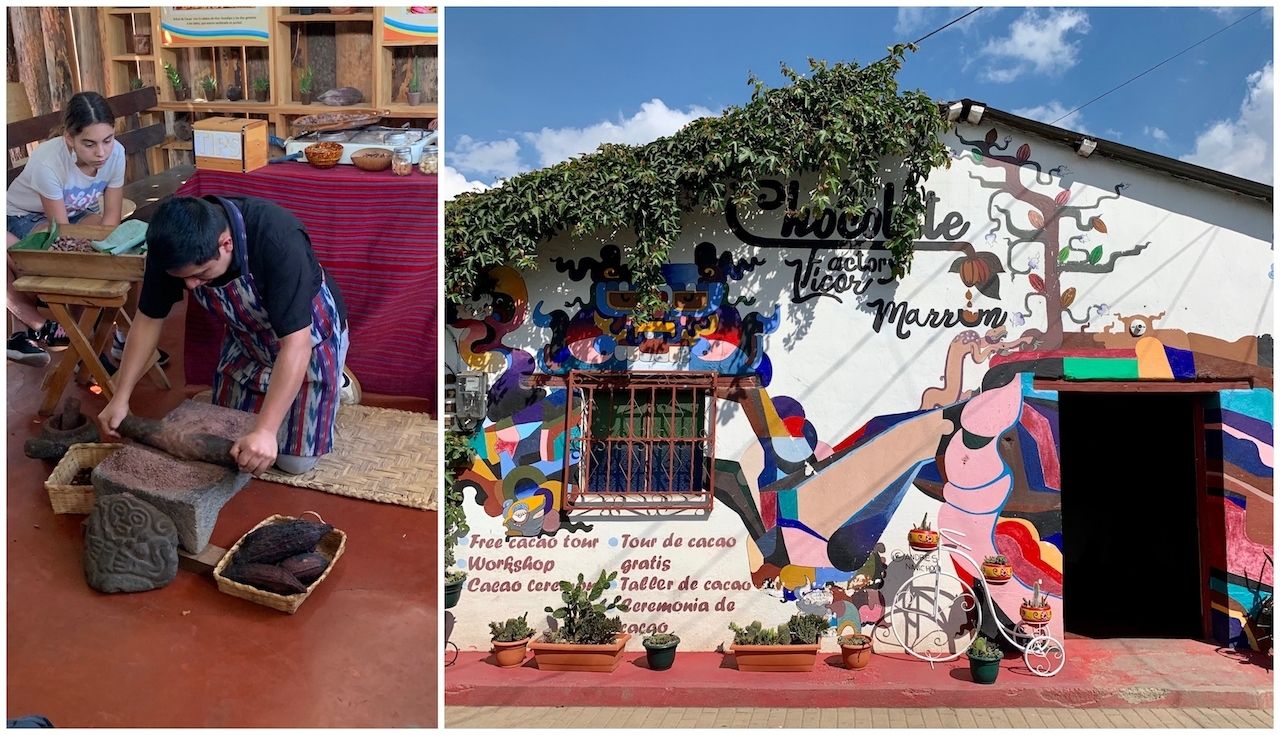
Photo: Fiona Mokry
Spend some quality time in San Juan on your last day. It’s one of the smaller and less-frequented villages around the lake, but the authentic food and cultural activities can fill a whole day. First, fill your belly at Restaurante Xe Kuku’ Aab’aj, an humble eatery with a rooftop deck overlooking the water. They serve the best ceviche and chicken pepián in Lake Atitlán — at local prices. After a savory meal, satisfy your sweet tooth and learn the significance of cacao in Mayan culture at Licor Marrón Chocolate. Watch artisans transform cacao into chocolate (or reserve a spot for the hands-on workshop and make your own) and then sample a traditional hot chocolate, the preferred method of chocolate consumption in Guatemala. Thought to have descended from the gods, cacao is a popular and highly regarded food throughout the country. It comes in many forms, from steamy liquid to solid spiced bars. After the cacao lesson, pick up some bars of homemade chocolate spiked with chili, cardamom, and ginger and a few ‘cacao bombs’ — small cubes of pressed cacao — to recreate your own hot chocolate at home just by adding hot milk.
The art of food is just one of San Juan’s attractions. Residents also showcase their talents with depictions of Mayan history and ancestral traditions through murals and paintings. With the spare time you have left, wander around San Juan and admire the wall murals, or pop into a few of the art galleries scattered throughout the village. Learn more about indigenous Tz’utujil beliefs and how it translates into art by taking a workshop from any one of the studios. Before you leave San Juan, end the day with a quick 15-minute jaunt up to El Cerro de la Cruz — the highest point overlooking San Juan — to take in one last lake landscape before your trip comes to a close.